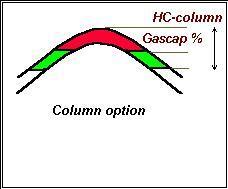HC column appraisal option in the Gaea50 program

This option assumes that the user has some idea about the range of possibilities of "degree of fill" of the trap. Instead of simulating charge with the FMB, the entrapped charge is estimated as the column length of HC in the trap in m. A user-defined histogram may be the best way to describe one's uncertainty about this. For instance a risk of not having any HC can be easily included.
The Gascap percentage is the % of the HC column that is free gas. Clearly, a zero percentage makes the whole column oil, and hence the prospect an exclusive oil prospect. In more common cases a range of percentages will be used leading to a variety of oil and gas volumes in the trap.
The user should realize the somewhat distorted relationship between vertical, one dimensional columns and three-dimensional volumes. So, the percentages of gas column are not the same as the resulting volume % of gas. Fortunately, in most gentle structures, this essentially non-linear relationship is close to linear.
The column option is useful in areas where SR information is scarce, or not well understood, such as in deltaic provinces. Often many fields with multiple reservoirs are already known. Calibration under such circumstances will be the collection of prior distributions of HC column lengths and the percentages of free gas in these. Note that the two parameters may be correlated in some way, and also be dependent on the depth and trap geometry. The simulation translates the column lengths into HC volumes by the trap geometry description provided by the user.
The simulation may try to combine some illogical combinations of data. For instance the user distribution of HC column length may result in a column that exceeds the vertical closure or spill/leak point. Appropriate truncation is then made by the model.
The HC column option actually models charge and retention implicitly as the column length is the result of the charge, entrapment and retention phases.